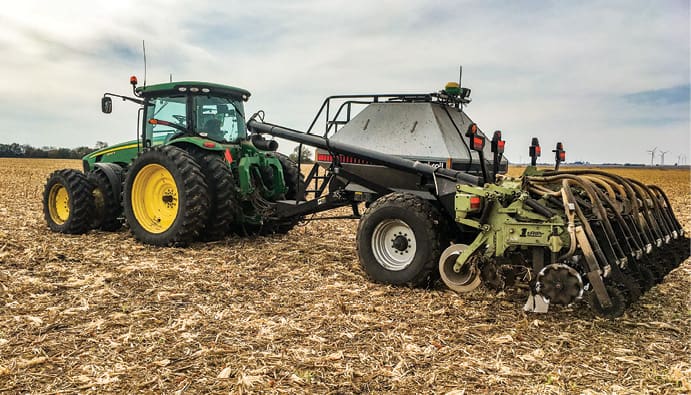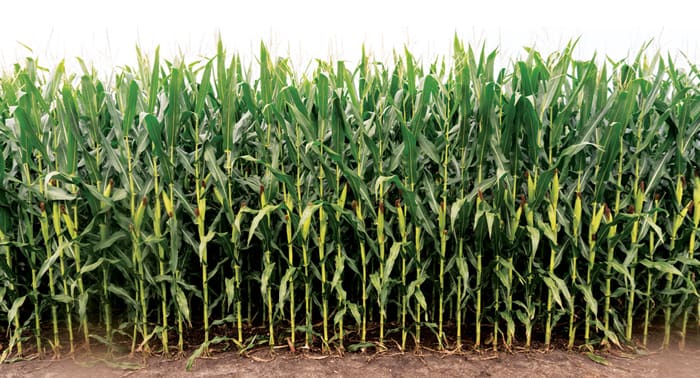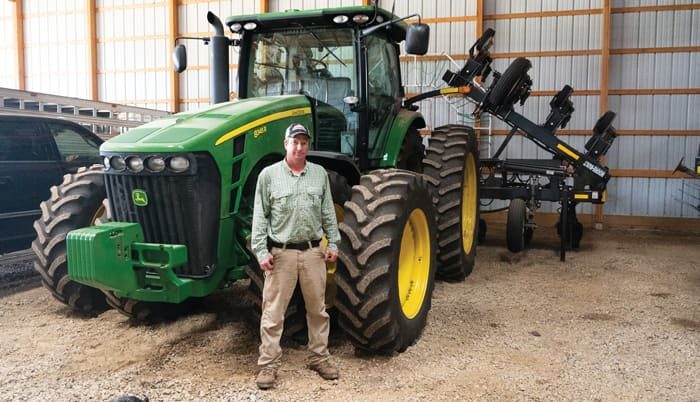For decades, the spring season was consistently stressful for Sparland, Ill., grower Jay Riddell. He dedicated days to running a field cultivator though his 1,500 corn and soybean acres while hoping for a suitable seedbed to plant into.
Factor in the 100 Hereford cattle he tends to on his operation, and he couldn’t help but wonder if a more feasible solution existed to balance the workload. Intrigued by the prospect of strip-till, he rented a DMI bar ahead of the 2008 season and applied anhydrous into fall strips to evaluate the system.
He’s since transitioned rigs and abandoned fall anhydrous due to inconsistency window of opportunity after harvest. The newfound simplicity of planting the following spring was enough for him to commit full-time, purchasing the 8-row Orthman 1tRIPr system he uses to this day.
“Spring goes fairly quick and easy. We can just go out and hop in the planter,” Riddell says. “Having residue between the rows, our strips are often dry a day before anything would be fit to field cultivate, but we could go out and plant if we wanted to. The strip is just so unbelievably mellow after going through the freeze and thaw.”
“I expect to spend more on the areas that raise 300 bushels of corn. At the end of day, my cost per bushel will be the same across the entire field if we’re doing everything right...” — Jay Riddell
Managing the operation with his father, Bill, and oldest son, Ryan, roughly 95% of Riddell’s total acres are strip-tilled split 60% corn and 40% soybeans. The remainder of the land dedicated to custom farming projects.
Most of his operation is encompassed by high-quality Muscatine silt loam soil, with certain regions holding lighter timber soils. His acres are relatively flat, with a 2-5% slope. But with drainage systems installed in the majority of his fields, flooding is a non-factor for the operation.
Dry-Fertilizer Differentiation
During fall strip-till, Riddell also operates a 1330 Flexi-Coil 2-bin dry banded fertilizer cart with hydraulic drive that enables him to variable-rate apply his nitrogen (N), phosphorus (P), potassium (K) and sulfur (S) in the form of diammonium phosphate (DAP) or monoammonium phosphate (MAP) mixtures using his Orthman bar 9 inches deep into the strip.
Applying 240 pounds per acre for both crops, his corn application consists of 13N-61P-91K-10S, while electing for 11N-53P-78K-9S on soybeans.

VARIABLE-RATE RESOURCEFULNESS. Working with several data service providers including Encirca for variable-rate recommendations, Jay Riddell applies blended loads of nitrogen, phosphorus, sulfur and potassium with a 1330 Flexi-Coil 2-bin dry banded fertilizer cart.
“I like the shank system and getting down deep,” Riddell says. “We’ve been applying about a third less of dry fertilizer than farmers who broadcast apply without hurting anything, and the stand of our crops have certainly improved with strip-till,” Riddell says. “We feel that with the dry, we can give the crop what it needs, exactly where it needs it. If you’re going to spread it on every inch of the ground, we’d much rather put the dry down where the crop’s going to get to it this year.”
Predicated on Precision
Riddell elects to have most of his N applied throughout the spring, explaining the low N totals in his DAP and MAP fall blends. The first application of spring N — done as a broadcast one week before corn planting — consists of 32% N at 35 units per acre. With the exception of corn fungicide being applied via helicopter, Riddell uses a John Deere 4930 sprayer with 120-foot booms to apply his spring nutrients. The sprayer comes equipped with the Raven Hawkeye Nozzle Control system, providing turn compensation and variable-rate capability through the pulsating nozzle.
Post broadcast, the remaining balance of N is sidedressed later in the season as an anhydrous application using Yetter 10000 Magnum Opener fertilizer coulter.
“I try to let that corn get as big as possible before running through it, just so we have as much nitrogen as we can late into the season and through the grain fill stages,” Riddell says.”
Powered by a John Deere 8345 tractor, Riddell’s 16-row Deere 1770 planter is equipped with a bevy of Precision Planting technology attachments, including SpeedTube for seeding speed, vSet for seed singulation, vApply for insecticide application, CleanSweep row cleaners for residue management and the DeltaForce hydraulic down pressure system to compensate for any varying terrain on his acres. Both his Orthman rig and planter are equipped with a Deere GPS system to ensure the planter maintains the same track in the spring.
Strip-Tilled Soybean Success
The decision to strip-till soybeans in addition to corn has brought several benefits to Riddell’s operation, including the luxury of maintaining a single planter for corn and soybeans. From an efficiency standpoint, the consistency of 30-inch rows for both crops gives Riddell flexibility in his planting schedule.
“This year in particular, we had a seven-day window where we needed to wait on corn after that first broadcast pass of 32% N and pre-emergence chemicals,” Riddell says. “Since it was good enough to plant, we did all of our soybeans ahead of the corn. That was only because we had the strips made and the ground was dry and warm.”
“With dry fertilizer we can give the crop what it needs, exactly where it needs it. If you’re going to spread it on every inch of the ground, we’d much rather put it down where the crop’s going to reach it this year...” — Jay Riddell
By combining 30-inch consistency with variable-rate capability, Riddell is able to predetermine seeding populations and load them into the planter prior to making a run through the field. Since switching over to strip-till and running the high-speed planter, Riddell says he’s been able to reduce seeding rates to approximately 100,000 per acre across many of his soybean acres.
His averages were closer to 180,000 formerly with a Kinze split-row planter and 200,000 with a no-till drill prior to that.
“It’s not a direct comparison because we spend significantly more now on seed treatments with fungicide,” Riddell says. “It’s not like we cut that seed price in half, we’re just spending more on what we put into the ground while not using as much seed overall. But we’re spending smarter dollars.”
Magnified Management Zones
As a significant investor in data collection for zone-specific seeding and fertilizer prescription rates, Riddell collects crop data on his iPad through Climate Corp.’s FieldView and also subscribes to the Pioneer Encirca nutrient management program so he can have multiple reference points before committing to a prescription.
Riddell leans on the Encirca model — which breaks down different regions into continuously updated environmental response units — as the primary benchmark for N prescriptions and yield goals based on projected rainfall. He works with Progressive Ag, a precision Ag servicer based out of Atlanta, Ill., to set up management zones and interpret data on variable-rate based on the Encirca calculations.
Now in his second full year of management zones, Riddell says utilizing the strengths of both programs provides assurance in his final seeding and fertilizer decisions.
“Some programs make prescriptions based only off organic matter, but to me, organic matter is just one piece of the puzzle for a management zone,” Riddell says. “Encirca is included in our contract with Progressive Ag, so it’s hard to put a dollar value on just it. But getting 2 different models allows us to check them against each other, which gives us peace of mind when analyzing the projections.”
Variable-rate recommendations are especially valuable for Riddell’s corn acres, as he plants both Stone Seed and Pioneer hybrid varieties within the same field in some instances.

EFFICIENT FERTILITY, CONSISTENT CORN. Committing to dry fertilizer placement into the strip at 9 inches deep during the fall, Jay Riddell says he’s able to apply 2/3 the rate of broadcast methods while maintaining a fortified corn stand.
“Different varieties of corn, especially on the N side, like their nutrients at different times and at different amounts,” Riddell says. “There are times when the planter can be running across 3 different management zones at once, but each individual row can adjust to whatever the prescription calls for.”
With weather patterns being capable of impacting recommendations, Riddell waits only 2 or 3 days prior to the actual planting date to finalize prescriptions. The primary goal for management zones, Riddell adds, isn’t to achieve bottom line savings on fertilizer or seed input, but to take a customized, region-by-region approach based on yield potential to equalize costs per bushel.
Land cost aside, Riddell aims to keep soybeans soybeans under $5 per bushel and corn under $2.25 per bushel in 2018
“It’s about reallocating to areas of the field that we felt weren’t being pushed had enough while also identifying areas of the field that were reaching their potential so we don’t over-apply seed or fertilizer,” Riddell says. “The goal was never to equalize the yield across the field. What I want to equalize is my cost per bushel. I expect to spend more on the areas that raise 300 bushels of corn. At the end of day, my cost per bushel will be the same across the entire field if we’re doing everything right.”
The past two seasons have produced record results on Riddell’s operation, with average corn yields reaching 270 bushels per acre and soybeans reaching 78 bushels per acre in 2018. Going forward, Riddell want to find additional data sources to verify the accuracy of his management zones. This past fall, he used a Veris machine across several of his fields providing information on soil texture readings to fine tune management zones further.
“I’m surprised by different areas of the field every year, so trying to take these management zones to high-definition and get them a little more exact, because I think we’re missing on them in some areas,” Riddell says. “Between the tests from Veris, Encirca and Climate, it will help us to say, ‘OK, that management zone really should have a yield goal of 290 instead of 275, it just needed this much more fertilizer to get there.’”
Complementing the soil analysis are tissue tests over the past two growing seasons, which he conducts though his fertilizer supplier, Helena Chemical Co. Primarily focusing on corn, he conducts the tests at three different stages of the year to evaluate how the crop is utilizing fertilizer across different growth stages. The tissue tests, he adds, provide a more accurate glimpse into fertilizer needs than soil tests given his dry fertilizer application method with strip-till.
Tissue Test Detection
To learn more about Jay Riddell’s transition to strip-till and variable-rate approach with management zones and tissue testing, visit the website of our sister publication Strip-Till Farmer at https://www.striptillfarmer.com/media/videos
“We still soil test every four years, but mainly for pH because we’re having trouble figuring out where the fertilizer is and how much we need to put on,” Riddell says. “I don’t feel that soil tests are the best way to project fertilizer needs for the crop, whereas the tissue tests enable us to have a ‘snapshot in time’ of what that plant truly needs. From there, along with the management zone recommendations, we can identify areas where we could push fertilizer harder and other areas where maybe we’re putting on too much.”
For this season, he took samples at 3-week intervals starting on June 20, July 5 and again in the final week of July. Since the banded dry fertilizer is applied at 9 inches deep, he anticipates the earlier tests to indicate low levels of P and K with the expectation of more sufficient findings by the time the second and third tests come around.
The results over the different stages, Riddell adds, serve as a template for how to approach next season’s application methods as opposed to making any adjustments within the same growing season.
“The deficiencies in those early tests tell me that perhaps the we need to incorporate some sort of starter program or something to get that dry fertilizer into the plant — especially the K — a little bit earlier,” Riddell says. “The main objective is to see whether those early K deficiencies have any impact on our yield or our bottom line.”








Post a comment
Report Abusive Comment